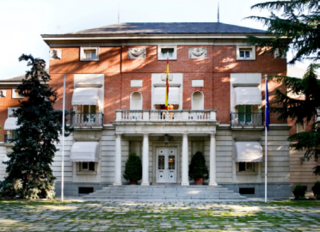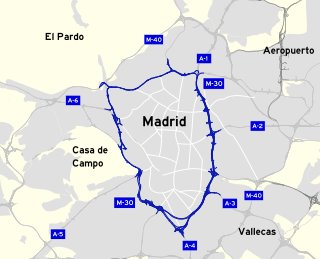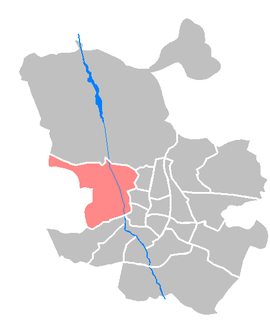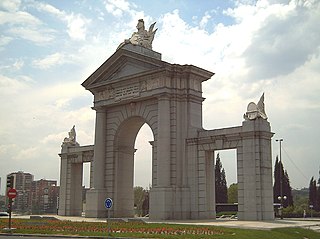
The Zarzuela Palace is the residence and working offices of the reigning monarch of Spain, although the official residence of the Spanish royal family is the Royal Palace of Madrid. The Zarzuela Palace is on the outskirts of Madrid, near the Royal Palace of El Pardo, which accommodates visiting heads of state. The palace is owned by the Spanish government and administered by a state agency named Patrimonio Nacional.

The Palace of Moncloa or Moncloa Palace is the official residence and workplace of the Prime Minister of Spain. It is located in Puerta de Hierro Avenue, in the Moncloa-Aravaca district in Madrid. It has been the official residence of the Prime Minister since 1977, when Adolfo Suárez moved the residence from the Palace of Villamejor.

Villanueva de la Cañada is a municipality in the Community of Madrid, Spain. Located 30 km north-west from Madrid, the municipality covers an area of 34.92 km2. Geographically, it sits on a large plain, in which there are several promontories, on one of which is found the castle of Aulencia, its main landmark. The ESA's European Space Astronomy Centre lies close to the former, on the Guadarrama riverfront. Villafranca del Castillo, a well-off urban area detached from the main nucleus, is located within the municipal bounds. Villanueva de la Cañada hosts the main campus of the Alfonso X El Sabio University as well as the Aquópolis waterpark.

The Puerta del Sol is a public square in Madrid, one of the best known and busiest places in the city. This is the centre of the radial network of Spanish roads. The square also contains the famous clock whose bells mark the traditional eating of the Twelve Grapes and the beginning of a new year. The New Year's celebration has been broadcast live since 31 December 1962 on major radio and television networks including Atresmedia and RTVE.

The M-30 orbital motorway circles the central districts of Madrid, the capital city of Spain. It is the innermost ring road of the Spanish city, with a length of 32.5 km. Outer rings are named M-40, M-45 and M-50. Its length and the surface surrounded by the M-30 is comparable to the Boulevard Périphérique of Paris or the London Inner Ring Road.

Majadahonda is a municipality in Spain, situated 16 km (9.9 mi) northwest of Madrid, in the Community of Madrid.

Paseo de la Castellana, commonly known as La Castellana, is a major street in Madrid, Spain. Cutting across the city from South to North, it has been described as the "true structuring axis" of the city.
The Battle of Ciudad Universitaria was a belligerent confrontation at the start of the defense of Madrid in the Spanish Civil War. This battle happened in the new campus area of the Ciudad Universitaria from the 15 to the 23 of November 1936 leaving a stable front until the end of the war. The republican militias' objective was "the defense of the capital at all costs", and for that, it was necessary to stop the advance of general Valera's troops and the fall of Madrid. On the other side, the attackers had as an objective to "conquer the city" as fast as possible. The persistence and tenacity of both sides in the battle meant an inflection point on the Spanish Civil War, partly because it was the first time that Franco's troops were stopped. The campus was also one of the most long-lasting confrontation points during the Spanish Civil War. The resistance shown in Madrid raised the morality of other fronts amongst the Gobierno de la República's controlled zone. The end of the battling period on the 23 of November 1936 was because of a change in strategy on part of the attackers. Between the main characteristics of this confrontation, it is worth mentioning the entrance to battle, for the first time in this war, of the varied troops that belonged to the International Brigades, just like the heavy military material of Soviet origins. The attackers received material and troops from Germany and Italy, being also one of the first times in history in which aerial bombing against the civil population was used.
Puerta de Hierro means "Iron Gate" in Spanish. It may mean:

Valdemarín is a ward (barrio) of Madrid belonging to the district of Moncloa-Aravaca. Its code number is 95 and, as of 2006, its population was of 4,000.

Puerta de Hierro, el exilio de Perón is a 2012 Argentine film. It is based on the exile of Argentine president Juan Perón, who was deposed in 1955 by a military coup named Revolución Libertadora, left the country, and finally returned in 1973. The actor playing Perón is Víctor Laplace.

Madrid is the capital and most populous city of Spain. The city has almost 3.4 million inhabitants and a metropolitan area population of approximately 6.7 million. It is the second-largest city in the European Union (EU), and its monocentric metropolitan area is the second-largest in the EU. The municipality covers 604.3 km2 (233.3 sq mi) geographical area.

Moncloa is a multimodal station in Madrid, Spain that serves Madrid Metro Line 3 and Line 6, as well as city buses and intercity and long-distance coaches. It is located underneath Moncloa square and Princesa street near Arco de la Victoria and the headquarters of the Spanish Air Force in fare Zone A.

The Field Elm cultivar Ulmus minor 'Dehesa de la Villa' was cloned by root cuttings from a tree growing in the eponymous park within the Moncloa-Aravaca district of north-west Madrid, by researchers at the Escuela Técnica Superior de Ingenieros de Montes, Universidad Politėcnica de Madrid in 1990.
The Christian Walls of Madrid, also known as Medieval Walls, were built in the Spanish city of Madrid between the 11th and 12th centuries, once the city passed to the Crown of Castile. They were built as an extension of the original walled enclosure of Muslim origin,to accommodate the new districts which emerged after the Reconquista.
The Walls del Arrabal were the third in a set of five walls built around Madrid, now the capital of Spain. There are no remaining ruins of the Walls del Arrabal, leaving some debate as to their extent and the period of their construction. It is possible that the walls were built as early as the 12th century, however they were most likely constructed in 1438. The walls may have been intended to protect people against the plagues that ravaged the city at the time. The walls united the urbanized suburbs of the city and prevented entry of the infected.

Real Club de la Puerta de Hierro, commonly known as Puerta de Hierro, is a private country club based in Madrid, Spain. It owes its name to the nearby iron memorial arch. Notorious for being associated with the royal families of Europe and the long-established elite, American President Gerald Ford called it "the club of kings and the king of clubs".

The plaza de Santo Domingo is a public square in the city of Madrid, Spain.

The Puerta de San Vicente is a monumental gate located in the Glorieta de San Vicente in Madrid (Spain). Since 1995, it has occupied the space where the original door, designed by architect Francesco Sabatini, was located between 1775 and 1892.

The 1991 European Amateur Team Championship took place 26–30 June at Real Club de la Puerta de Hierro in Madrid, Spain. It was the 17th men's golf European Amateur Team Championship.

















